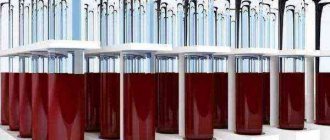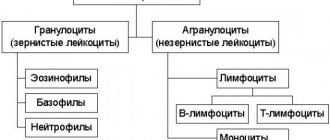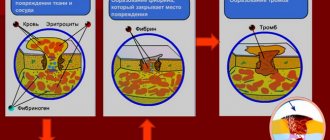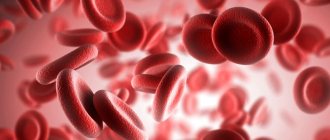40
Author of the article: Marina Dmitrievna
2017.09.15
17 956
Blood analysis
A biochemical blood test involves a detailed study, which helps to quickly establish a diagnosis. If a patient often suffers from tonsillitis, pharyngitis, or tonsillitis, the doctor recommends taking an ASLO test. This blood count represents the antibodies the body produces against antistreptolysin-O.
Avoid complications
It is extremely difficult to detect GABHS immediately after colonization in the first days of the disease, and in the blood it is completely impossible, because time must pass for the streptococcus to become accustomed and for the immune system of the infection carrier to respond, that is, the immunocompetent cells give the command to turn on humoral immunity and produce antibodies, aimed at the antigenic structure of the infectious agent.
These antibodies will become ASLO or antistreptolysin-O - and then an increased level of the indicator can be expected. But until the body detects the “guest” and begins to synthesize antibodies, traces of β-hemolytic streptococcus will not be detected in the blood of a person who has contracted the infection. Knowing the origin of the inflammatory disease (tonsillopharyngitis) is very important when it comes to a child, because only sore throat of streptococcal etiology requires the use of antibacterial therapy (antibiotics); other processes can do without it. Studying ASLO will help avoid frequent and often unnecessary use of antibiotics and prevent possible complications, the most “expected” of which is acute rheumatic fever
Recently, hopes have arisen that in the near future a vaccine will be created that will stop the spread of GABHS in the human population; it is currently under development. This is the drug StrepAvax (composition: sections of M-proteins of the 26 most common serotypes of β-hemolytic streptococcus). Of course, one cannot count on solving all problems with regard to dangerous microorganisms of this kind without exception, but there is also no reason to doubt that the use of a vaccine will reduce the incidence and number of complications. In the meantime, let's hope for a laboratory criterion such as antistreptolysin-O or ASLO, which will help to make a timely diagnosis, begin treatment and prevent complications.
Variants of results in dynamics
This laboratory test is suitable for monitoring the course of a pathological process, but I would like to draw the reader’s attention to the fact that a single test of antibody concentration will not be particularly informative in terms of diagnosis and prognosis, so tests should be carried out serially with an interval of one week (7 days). And here there are various options:
And here there are various options:
The titer of antistreptolysin-O begins to increase approximately a week after the pathogen enters. The peak occurs at 3-5 weeks and, if everything goes well (the body can handle it), the ASLO level will begin to decrease and reach normal values by six months to a year.
A persistent increase in the concentration of antibodies to the beta-hemolytic streptococcus antigen gives reason to suspect a later complication of the infection - the rheumatic process. The development of the rheumatic process can be assumed after a sore throat (with a long-term, not changing towards a decrease in the activity of antistreptolysin-O).
A favorable course of the rheumatic process (without involving the heart in the process) is indicated (and encouraging in terms of prognosis) by a decrease in the ASLO titer to normal by the end of the first or second month of the disease. With adequate treatment, these periods can be significantly reduced.
On the contrary, the absence of changes in ASLO titers towards a decrease (they continue to remain high six months after the onset of the disease) complicates the prognosis and makes one think about the onset of a relapse.
Despite the great diagnostic value of this laboratory test (ASLO), it should still be borne in mind that in the blood of individual patients, who can account for up to 15% of those with rheumatism, an increase in the titer of antibodies to streptolysin is not detected. And, conversely, relatively high levels are sometimes observed in carriers of the pathogen who do not have any signs of the disease. Elevated ASLO titers can also be expected in the blood of people with chronic tonsillitis, rheumatoid arthritis, or in carriers of streptococcal infection who consider themselves healthy because it is in a state of “hibernation” (albeit for a certain time).
graph: example of the dynamics of ASLO levels during streptococcal infection
It is known that the main reason for increased ASO activity is sensitization of the body with streptococcal antigen after penetration of streptococcal infection (in particular, Streptococcus pyogenes - GABHS). There is not much hope for post-infectious immunity in the event of infection - it does not differ in either severity or duration, but allows for a high risk of complications
Streptococcal infection often leads to the development of a rheumatic process and the formation of acquired heart defects in children, therefore, after a sore throat or other infections in a child, it is very important to find out the values of this indicator (was the disease caused by streptococcus?)
Meanwhile, an analysis such as ASLO is often offered to an adult. This test, along with other tests (RF-rhematoid factor and CRP - acute phase reactive protein) helps establish the diagnosis of rheumatoid arthritis, although in RA the activity of ASLO is significantly lower than in rheumatism.
About analysis, norms and deviations
To prevent harm caused by beta-hemolytic streptococcus to the human body, in order to detect the presence of group A beta-hemolytic streptococcus, a biochemical test of antibodies to the pathogen antigen, briefly called ASLO, is used in clinical laboratory diagnostics.
The normal titer of antibodies to streptolysin in different laboratories may differ slightly, however, the following indicators are accepted as the classic version of normal values:
- For adults and adolescents (over 14 years old) – up to 200 U/l;
- For children under 14 years old - up to 150 U/l.
The main methods for determining antistreptolysin-O is the latex test; the analysis is quick and inexpensive, allowing not only to detect a high concentration of antibodies, but also to determine their titer (the kit is equipped with the necessary reagents and includes titration). Some clinicians rely more on turbidimetric testing, which, however, requires additional equipment.
General information
Streptococci are divided into groups according to the type of effect and their characteristics. Group A beta-hemolytic streptococcus is the most dangerous, as it is the causative agent of serious pathologies:
- scarlet fever (a highly contagious (infectious) infectious disease);
- glomerulonephritis (damage to the glomeruli of the kidneys);
- tonsillitis and tonsillitis (inflammation of the tonsils);
- erysipelas (skin infection);
- rheumatic fever - rheumatism (inflammation of connective tissue);
- osteomyelitis (purulent-necrotic process in soft tissues, bone and bone marrow);
- bacterial endocarditis (damage to the inner lining of the heart muscle);
- pyoderma (purulent skin lesion), etc.
Different types of toxins released by bacteria cause different pathological symptoms or syndromes. One of these components is the protein streptolysin, which damages red blood cells - erythrocytes. In response to the release of streptolysin, the body secretes antibodies (Anti-streptolysin-O). Their concentration begins to increase 1-5 months after infection with streptococcal infection. The ASL-O indicator returns to normal only after six months to a year.
Research results and their possible dynamics
Let us recall that the study is of diagnostic value if it monitors the dynamics of changes in antibody levels. For this purpose, they are carried out several times.
Let's look at how to decipher the results of laboratory tests as they are carried out.
- The peak of elevated rates is recorded a month after infection. Then it begins a slow and steady decline, which indicates that the body is coping with the pathology.
- A persistent increase in antigen levels is classified as a course of the rheumatic process. A similar complication can also be diagnosed after a sore throat.
- The success of rheumatism treatment is indicated by even a slight decrease in titers 2 months after the onset of the disease.
- The absence of downward dynamics within six months indicates the presence of a relapse.
What to do if abnormalities in the blood test for ASLO are detected? Inflated digital indicators of this laboratory study record the past pathology associated with streptococci. However, high titre values do not pose a danger to human life and health. Therefore, measures aimed at normalizing ASLO are not being taken, while continuing to monitor the dynamics of possible changes.
Laboratory testing to determine the level of ASLO is more informative in children. This is due to the correct determination of the nature of the disease. Thus, identifying the streptococcal nature of a sore throat requires the use of antibiotics, while other types do not require their use. Incorrect therapy will cause dangerous complications associated with disruption of the functioning of vital internal organs. Such a diagnosis will help determine the advisability of prescribing a specific treatment.
It should be remembered that it makes no sense to decipher the results of the research on your own. This issue is resolved by qualified doctors.
This laboratory test is suitable for monitoring the course of a pathological process, but I would like to draw the reader’s attention to the fact that a single test of antibody concentration will not be particularly informative in terms of diagnosis and prognosis, so tests should be carried out serially with an interval of one week (7 days). The titer of antistreptolysin-O begins to increase approximately a week after the pathogen enters
The peak occurs at 3-5 weeks and, if everything goes well (the body can cope), the ASLO level will begin to decrease and by six months to a year will reach normal values
The titer of antistreptolysin-O begins to increase approximately a week after the pathogen enters. The peak occurs at 3-5 weeks and, if everything goes well (the body can handle it), the ASLO level will begin to decrease and reach normal values by six months to a year.
A persistent increase in the concentration of antibodies to the beta-hemolytic streptococcus antigen gives reason to suspect a later complication of the infection - the rheumatic process. The development of the rheumatic process can be assumed after a sore throat (with a long-term, not changing towards a decrease in the activity of antistreptolysin-O).
On the contrary, the absence of changes in ASLO titers towards a decrease (they continue to remain high six months after the onset of the disease) complicates the prognosis and makes one think about the onset of a relapse.
Despite the great diagnostic value of this laboratory test (ASLO), it should still be borne in mind that in the blood of individual patients, who can account for up to 15% of those with rheumatism, an increase in the titer of antibodies to streptolysin is not detected. And, conversely, relatively high levels are sometimes observed in carriers of the pathogen who do not have any signs of the disease.
graph: example of the dynamics of ASLO levels during streptococcal infection
It is known that the main reason for increased ASO activity is sensitization of the body with streptococcal antigen after penetration of streptococcal infection (in particular, Streptococcus pyogenes - GABHS). There is not much hope for post-infectious immunity in the event of infection - it does not differ in severity or duration, but it does allow for a high risk of complications.
Meanwhile, an analysis such as ASLO is often offered to an adult. This test, along with other tests (RF-rhematoid factor and CRP - acute phase reactive protein) helps establish the diagnosis of rheumatoid arthritis, although in RA the activity of ASLO is significantly lower than in rheumatism.
Phytotherapy
As a preventative measure, you can use onions and garlic without additional processing. They cope well with bacteria, including streptococcus, at the initial stage of infection, before the infection spreads throughout the body.
To lower ASLO levels, specially selected decoctions, teas and infusions are used. Raspberry leaves, cranberries, and rose hips have a diuretic effect and help remove germs. Cranberries and rose hips can be used both natural and dried.
Fresh hop cones are a powerful remedy in the fight against infection. Here is one recipe for a healing decoction based on them:
- 8-9 hop cones pour ½ liter of boiling water,
- Cover with a lid
- Let it brew for 4 hours
- Drink 3 times a day before meals (10-20 minutes). The decoction should be consumed warm.
Keep in mind that the healing properties of the decoction last only 12 hours, so you will have to brew the “healing elixir” every day.
Antistreptolysin O or ASL - O
Before finding out the level of ASLO in the blood and what it is, let's learn more about the antigenic structure of streptococcus. This will help to better understand the pattern of antibody production.
Gram-positive streptococci secrete enzymes. One of these enzymes is streptolysin. It plays an important role in the formation of the immune response, and is toxic to heart tissue, capable of causing hemolysis of red blood cells, a rise in temperature, and the appearance of a rash in scarlet fever.
The body reacts to this aggression by releasing antistreptolysin O. This is how the immune system tries to protect the targets - the mucous membranes and epidermis. But such antibodies are only capable of eliminating the waste products of bacteria; they are powerless against streptococcus itself. Therefore, it is impossible to do without proper and timely treatment.
But when making a diagnosis, it is still worth considering the nuances of increasing the number of antibodies in a blood test:
- The increase in concentration begins only after 3-5 weeks of infection;
- After reaching the maximum level, the level decreases;
- High results of ASLO can last for 6 months. up to a year;
- If measures were not taken in time, and the concentration of antistreptosilin was high for a long time, then this may result in complications in the form of rheumatic fever. In this case, stabilization of indicators occurs after 4-8 months;
- If within 6 months. the ASLO level remains high, then the patient should expect a relapse of the disease and need to prepare for an attack.
It is worth noting that in 15% of infected people, antistreptolysin remains at a normal level, so you should not rely on this analysis alone, without taking into account other methods.
A short video about streptococcus:
Description of the indicator
Testing for ASLO is a blood fluid analysis related to rheumatic tests. Thanks to it, it is possible to identify heart defects, rheumatoid arthritis, and also predict their development.
During the study, the laboratory technician identifies antibodies to the hemolytic streptococcus group, the production of which is carried out by the human immune system. In order for them to begin to be produced, infection must penetrate.
Representatives of pathogenic flora are constantly encountered. But, thanks to the protective functions of the body, bacteria are unable to penetrate the skin layers and mucous membranes. Therefore, no toxic substances are released.
Indications for examination
For timely diagnosis, as well as monitoring the course of the disease, a blood test for antistreptolysin is prescribed.
Group A streptococcus can cause diseases such as:
- Scarlet fever;
- I give birth;
- Tonsillitis (tonsillitis);
- Pyoderma is a purulent lesion of the skin;
- Rheumatic fever;
- Glomerulonephritis – damage to the glomeruli.
Without timely medical intervention, the likelihood of complications increases significantly. May be affected:
- Joints;
- Cardiac muscle;
- Renal nephrons;
- Nervous system.
All this helps prevent the detection of ASLO levels. Abroad, undergoing such an examination for diseases of the heart, kidneys, and nervous system is mandatory for children. And even a year after they have been cured, specialists prescribe a repeat test for antistreptolysin - O. This is done to make a more accurate diagnosis, as well as to exclude the possibility of relapse.
It is assigned to solve the following tasks:
- To identify the fact that the patient was recently infected with streptococcus A;
- Assess his current condition and predict the further course of the disease;
- Identify arthritis in acute rheumatic fever;
- Assessment of the condition after 2 weeks of therapy for rheumatism and glomerulonephritis.
A blood test for ASLO is prescribed for all patients suffering from the following ailments:
- Arthritis;
- Arthrosis;
- Painful sensations in the back;
- Pharyngitis is an inflammatory process in the mucous membrane and lymphocyte tissue;
- Angina;
- Laryngitis;
- Tracheitis – inflammation in the tracheal area;
- Nasopharyngitis is an inflammatory lesion of the nasopharynx;
- Scarlet fever.
Biochemical examination is one of the mandatory points of the examination program for patients with rheumatism, glomerulonephritis and myocarditis.
During dispensary treatment, patients have to donate blood 2 times a year before starting an anti-relapse course of therapy. The first donation is made 30 days after suffering from infectious respiratory diseases. Antibody concentrations begin to rise during this period, reaching a peak value at 6 weeks. A control blood sample is taken six months later, because this is how long the body needs for complete recovery.
Rules for preparing for diagnostics
A high-quality result directly depends on a reasonable approach to preparation. You can stick to this plan. 6–7 days before diagnosis, it is necessary to avoid drinking all drinks containing alcohol, as well as stop using medications (if they are not considered mandatory).
2–4 days before a blood test for ASLO, it is advisable to limit as much as possible the consumption of spices, pickles, foods high in fat and salt, fast food, flour and confectionery products. During the last 2 days, physiological overexertion should be avoided. It is better to stop playing sports for this period of time.
You must take your last meal 8–12 hours before, as the test is taken on an empty stomach. The next morning you need to stop smoking. Before testing for ASLO, you should not undergo other forms of medical diagnostics, especially angiography, ultrasound, MRI, CT, fluorography, physiotherapy and massage.
You must take your last meal 8–12 hours before, as the test is taken on an empty stomach. The next morning you need to stop smoking. Before testing for ASLO, you should not undergo other forms of medical diagnostics, especially angiography, ultrasound, MRI, CT, fluorography, physiotherapy and massage.
The biomaterial for the study is venous blood, which is taken from the ulnar vein according to the standard venipuncture algorithm.
- Manipulation time is morning hours (from 8.00 to 11.00).
- A prerequisite is that blood is donated strictly on an empty stomach. It is allowed to drink clean drinking water without gas.
- 30-40 minutes before the manipulation, eliminate physical and emotional stress;
- half an hour before - do not smoke or consume nicotine-containing products (tobacco, chewing gum, spray, patch, etc.).
There are no special diet requirements for this test.
Other rheumatology screening tests
Additional examinations
Auxiliary diagnostic methods are prescribed without fail, but not to establish the fact of streptococcal infection (this is precisely established through an ASLO blood test), but as part of identifying the exact localization of the bacterial focus and the severity of the lesion.
Oral questioning of the patient
It is imperative to identify all health complaints; it is important not to miss anything. The clinical picture provides a lot of information about all aspects of the current pathological process
Anamnesis collection. Under what conditions the infection is believed to have occurred and for how long ago. Visual assessment of the pharynx. This is the job of an otolaryngologist. Based on the results, the ENT doctor can diagnose pharyngitis, tonsillitis or other lesions of the upper respiratory tract. Chest X-ray. To exclude pneumonia and bronchitis, which often develop upon contact with pyogenic flora. A throat swab with further bacteriological culture is required. This will confirm the infection with streptococcus and also detect the sensitivity of the pyogenic bacterium to a certain drug or antibiotic. Assessment of joint condition. Basic neurological examination. Study of reflexes.
Also other methods, as needed. The issue is resolved based on the specific situation.
Antistreptolysin-O increased
Sometimes the results of indicators can be overestimated, even in the absence of streptococcal infection.
ASLO in the blood is elevated in the following cases:
- for liver pathologies;
- when a patient is diagnosed with nephrotic syndrome;
- when taking glucocorticosteroids or antibacterial drugs;
- if the patient has not properly prepared for the test;
- with hemolysis of erythrocytes.
Antistreptolysin-O is elevated - reasons
There are a number of factors that influence the value of this indicator.
An increase in ASLO in the blood often has the following causes:
- erysipelas;
- rheumatic fever;
- pyoderma;
- diffuse glomerulonephritis;
- tonsillitis;
- sinusitis;
- otitis.
If antistreptolysin-O is elevated, only a doctor can say for sure what this means. However, this indicator more often indicates the development of streptococcal infection, which can be provoked as follows:
- contact with a carrier of this pathogenic microorganism;
- visiting places with large crowds of people;
- using common hygiene items.
ASLO is elevated in the blood - what to do?
If the number of antibodies is recorded at high levels, additional research is required. All prescriptions must be made by a doctor. When antistreptolysin-O is elevated - what does this even mean, he will explain in detail to the patient and answer all questions that arise. To obtain reliable information, all studies must be completed on time.
In most cases, when antistreptolysin is elevated in the blood, the following tests are prescribed:
- detection of uric acid levels in plasma;
- determination of blood saturation with C-reactive protein;
- immunological tests.
Antistreptolysin-O – treatment
All appointments must be made by a doctor. He knows what antistreptolysin is, what this analysis says, and what to do if the level is significantly higher than normal. Therapy for each patient is selected individually. More often it involves taking the following medications:
- antibiotics (Augmentin, Ampicillin);
- immunostimulants (Immunal);
- antihistamines (Suprastin).
If a high level of antistreptolysin is detected, in order not to aggravate the condition, you should adhere to the following recommendations:
Do not self-medicate! Be wary of alternative medicine, since some herbal remedies are incompatible with antibiotics. If folk remedies are taken during therapy, they must be agreed with the doctor.. https://www.youtube.com/embed/LzKjnKHeOVE
Treatment methods
If antistreptolysin O is elevated, this means that there is an infectious process involving pyogenic flora (in particular streptococcus), and the use of antibiotics is necessary.
But without assessing the sensitivity of microorganisms to specific types of these medications, there is no point in prescribing therapy.
It is necessary to examine the smear and select the most active drugs in a particular case. This is the main method of combating the pathological process.
If antistreptolysin-O is elevated in a child, it makes sense to prescribe medications in a hospital setting, especially if the disorder has a long history or is resistant to therapy.
In addition, anti-inflammatory drugs of non-steroidal origin are used. It is necessary to use immunomodulators according to indications. To restore the body's resistance to negative external influences.
Prescribing such drugs is the prerogative of a specialist, since without the approval of doctors, there is a high probability that the medications will be useless or have serious side effects. Since the dose is selected individually.
Antipyretics can be used as part of symptomatic correction. To eliminate symptoms such as fever and pain. These are products based on paracetamol and ibuprofen (they are much safer).
They cannot be used uncontrollably; the dosage must also be strictly observed so as not to provoke dangerous complications: bleeding, liver damage, and others.
Drug correction is the main one. In addition, it is necessary to maintain the body's systems in a normal state or eliminate changes that arose under the influence of streptococci.
Here everything depends on the specific disorder. Cardiac disorders require the use of cardioprotectors, antihypertensives, in some cases, organic nitrates, other medications, etc.
The task of therapy is solved by an infectious disease specialist, rheumatologist, or ENT specialist. The list goes on. It all depends on the specific diagnosis.
Antistreptolysin-O increases against the background of streptococcal damage to the body, as the name of the antibody suggests. This is an informative indicator for establishing the existence of a problem.
source
Carrying out analysis
No separate events are required. Antistreptolysin O is assessed as part of a standard biochemical blood test.
The procedure is carried out as follows:
- The patient comes to the laboratory. As a rule, the technique requires the collection of biomaterial in the morning. Between 7 and 9 o'clock. This is the best moment, since there are still no changes that could hinder the research and distort the picture.
- In addition, diagnosis must be done on an empty stomach. It is easiest to conduct such a study in the morning.
- Blood is drawn in an amount of 5 ml from a vein.
- After this, the tube with the collected material is labeled with the patient’s name and/or serial number and sent for a profile assessment by a laboratory specialist.
The activities are considered routine. They are carried out in most clinics under the compulsory health insurance policy.
It can also be paid, the cost is minimal. From 300 to 800 rubles in Russia (in the regions the price is lower than in Moscow and St. Petersburg).
Laboratory methods for identifying ASLO
ASLO is detected in a blood test using 2 laboratory methods:
- When a drop of the biomaterial is applied to 2 glass slides, a negative control is added to one sample, and a positive control to the other. Next, both samples are subjected to a chemical reaction through the use of a special latex reagent, after which these components are combined with each other and placed in a dispersant to obtain a homogenized (homogeneous) mixture. This is followed by the study of ASLO components in the sample.
- As soon as the antibodies react to encounter pathological antigens, the specialist will begin to count the formed complexes in a scattered beam of light using an optical measuring device (photometer).
- When a drop of the biomaterial is applied to 2 glass slides, a negative control is added to one sample, and a positive control to the other. Next, both samples are subjected to a chemical reaction through the use of a special latex reagent, after which these components are combined with each other and placed in a dispersant to obtain a homogenized (homogeneous) mixture. This is followed by the study of ASLO components in the sample.
- As soon as the antibodies react to encounter pathological antigens, the specialist will begin to count the formed complexes in a scattered beam of light using an optical measuring device (photometer).
Blood for biochemical analysis is taken from a vein located near the elbow (less often from the hand or thigh).
Aslo in the blood: what is it, the norm in children, decoding of the indicator
Sometimes your doctor will prescribe an antistreptolysin-O test. After reading the article, you will learn what ASLO is, what features the preparation for it has, what the results of the analysis may mean, and how to react to an increased level of ASLO. We will also consider the possible consequences after infection with streptococci, and how to avoid them.
What is ASLO analysis, in what cases is it prescribed?
The ASLO (or antistreptolysin-O) test shows antibodies that are released in the blood when a streptococcal virus is detected in it. The immune system creates such a substance against the toxin streptolysin-O.
READ ALSO: Clinical blood test in children: interpretation and norm
Based on ASLO in the blood, the doctor can determine whether the body can cope with the infection on its own, what stage the disease is at, how it will develop further, and how effective the therapy is.
If a child often has a sore throat or other infectious disease, the attending physician will recommend testing for the presence of ASLO. The analysis is also prescribed for:
- determining the time of entry of the virus into the body;
- calculating the likelihood of complications after suffering from tonsillitis, scarlet fever and other diseases;
- assessing the effectiveness of therapy;
- identifying pathologies of the child’s heart, kidneys, and joints.
To test for ASLO, you need to take venous blood.
Norms of ASLO in the blood of children of different ages
The norm of the indicator when analyzing ASLO in children differs by age:
- in children under 7 years old – up to 100 IU/ml;
- in children from 7 to 14 years old – 150-200 IU/ml.
In order for the results to be objective, in order to track the dynamics of antibody concentrations, the analysis is carried out twice with an interval of 1 week
It is also important to do tests in one clinic, since acceptable standards may differ in different institutions. The best time to get tested is morning
What does an increased level of indicator in a child’s blood indicate?
The growth of their number in the body has its own dynamics. 1-2 weeks after streptococci enter the body, the first increase in antibodies is observed. When a child develops primary symptoms, the antigen level is normal. After 1-1.5 months, the highest concentration of antibodies is observed.
READ ALSO: Why can creatinine be elevated in a child’s blood?
Such monitoring of changes in indicators helps to monitor the course of the disease and, if necessary, take timely measures to eliminate unwanted complications. The doctor also draws conclusions about the effectiveness of the treatment.
A gradual decrease in the concentration of the substance indicates that the child is recovering. However, this decrease occurs slowly. For the indicators to return to normal, it is necessary for 6-8 months to pass after the first contact with the infection.
If, after this period, the ASLO analysis detects an increased level of markers, a relapse is possible. Based on the level of antibody concentration, it is impossible to say for sure whether there will be complications and how serious they are.
If therapeutic measures are taken in a timely manner, pathologies will not arise.
There is a small percentage of children whose test for ASLO shows no positive result in the presence of streptococcal infection.
According to statistics, an increase in the concentration of antibodies in the body after infection is observed in 4 out of 5 children.
Test for autoimmune and rheumatic diseases
In a broad sense, antistreptolysin (ASLO) is self-produced antibodies - the body’s reaction to the harmful activity of streptococci “A” (their toxins), which is streptolysin O. This type of bacterium can cause such complex diseases in a child as:
- lymphangitis;
- scarlet fever;
- acute pharyngitis;
- acute rheumatism;
- gangrene;
- pneumonia;
- glomerulonephritis;
- sinusitis;
- erysipelas.
If a blood test shows an elevated marker - antistreptolysin, the reason for this may be the development of pathogenic infections in the child’s body. The peak of a high ASLO rate is observed 4-6 weeks after infection, however, if the treatment was correct and timely, then after a month and a half, antistreptolysin returns to normal.
To diagnose autoimmune and rheumatic diseases in children, they take a blood test (a set of immunological procedures (rheumatic tests)). Researched:
- circulating immune complexes;
- saturation of C-reactive protein in the blood;
- uric acid;
- rheumatoid factor;
- protein norm.
In this regard, antistreptolysin O is considered an excellent marker. Its high level in the samples will confirm the antigen - streptolysin in the blood. In other words, the presence of bacteria in the body. Treatment of a child is usually based on antibiotics. If you do not delay it, recovery proceeds without relapse. Otherwise, children are diagnosed with post-streptococcal complications - the causes of the development of rheumatic fever and glamerulonephritis.
Streptococcal infections are very dangerous. In the body they produce streptolysin, a complex toxic compound. It has a toxic effect on organs, especially the heart, destroys blood cells, and spreads pathogenic bacteria throughout vital systems. Once streptococci enter the body, they begin to produce a byproduct, the antigen streptolysin. The child's immune system immediately reacts and begins to fight the toxins, releasing antistreptolysin antibodies. Their elevated levels can be diagnosed by a blood test. It is prescribed both during the period of illness and after an illness.
The doctor may order a blood test if your child:
- acute diffuse glumerulonephritis;
- myocardium;
- rheumatism;
- scarlet fever;
- sore throat;
- osteomyelitis;
- otitis.
An analysis for ASLO is not taken to diagnose the disease, since at the stage of infection of the body, its values are within normal limits and only after a week, the level of ALS becomes elevated. For more reliable information about the child’s health, a so-called serial analysis is performed - blood sampling every seven days. This approach helps to monitor antistreptolysin and, accordingly, the presence of such a toxic enzyme as streptosilin. A decrease in ASLO is observed within 6-12 months. If after six months the ASL level is still elevated, you need to be wary of complications.
How is the analysis and norm of ASL-O carried out?
The results of the analysis should be assessed by the local physician. Depending on other abnormalities and symptoms, a person may be referred to other specialists of a narrower profile for further treatment.
Normal values in adults are below the upper limit - 250 IU/ml. Other studies report values up to 200 IU/ml, so it is up to the treating specialist to determine the individual's condition in a particular case. The upper limit corresponds to age over 60 years, the lower limit to age from 14 years.
In pregnant women
To determine the cause, the indicator must be observed in dynamics:
- with increasing numbers, the disease is in the active stage;
- if the data is stable, the infection was previously present.
The interval between blood sampling for laboratory diagnostics is at least 7 days. A one-time study has virtually no informative value.
Antistreptolysin-O may be elevated due to the presence of other hidden infections. If an abnormal indicator is detected, it is recommended to undergo a series of examinations to identify some other pathogens:
- Epstein-Barr virus;
- cytomegalovirus;
- herpes type 6.
They are well determined by a blood test for igg antibodies. Their activity causes damage to the respiratory tract, against the background of which the growth of other infections begins. Treatment in this case is based on the use of antiviral drugs, since antibiotics do not act on viruses.
Only when bacterial complications begin can the doctor recommend another drug to avoid serious consequences and quickly suppress the associated infection. Parents should examine their child if he often suffers from colds. It is these symptoms that mask a streptococcal infection.
| Child's age | Norm, IU/ml |
| Children under 7 years old | Up to 100 |
| 7-14 years | 150-200 |
| Over 14 years old | Up to 250 |
Normal levels of antistreptolysin-O for boys and girls are at the same level.
Decoding the results
If the norms are exceeded according to three main criteria, we can conclude that certain diseases are present.
The result is positive
| High level of ASLO | High RF level | High CRP level |
| Rheumatoid arthritis | Rheumatoid arthritis | Inflammatory processes caused by diseases of the joints or bone tissue |
| Chronic tonsillitis | Infectious diseases (tuberculosis, influenza, rubella) | |
| Scarlet fever | Malignant tumors | |
| Osteomyelitis | Polymyositis | |
| lupus erythematosus | ||
| Injuries to the walls of blood vessels |
The results of rheumatic tests, as a rule, are provided to the patient a day after the biomaterial is submitted to them. Interpretation of results should only be carried out by a qualified specialist.
The result is negative
The result is considered negative when the values of the main indicators are within the normal range. This is not a reason to conduct a repeat rheumatic test.
Low results can also be affected by factors such as pregnancy, nervous or physical exhaustion.
In what cases is a blood test prescribed for ASLO?
The list of indications for this type of diagnosis is quite extensive. If we talk exclusively about physiological abnormalities that indicate significant disruptions that indicate an increase in ASLO levels, we can identify the following alarming symptoms:
| Localization of violations | List of signs |
| Respiratory system | Tachycardia (attacks of rapid breathing), chronic shortness of breath, hyperemia (purple spots located on the arches, tonsils and palate), purulent inclusions in the sputum, respiratory noise |
| Epidermis | Redness or paleness of the skin, small papular rash, cyanosis (blue appearance in some parts of the body), peeling and keratinization (i.e. hardening) |
| Genitourinary apparatus | Puffiness under the eyes, presence of bloody clots in the urine, kidney failure, painful and frequent urination |
| Heart muscle | Hypertension (high blood pressure), squeezing and cramping pain near the heart |
| Musculoskeletal system | Increased size of joints, burning and aching pain in the area of bone joints, especially aggravated by physical activity |
| central nervous system | Persistent headaches, drowsiness coupled with general weakness and fatigue, causeless aggression and irritability |
| Vessels | Increased content of low-density lipoproteins (“bad” cholesterol), enlarged lymph nodes (especially in the neck) with their further compaction, minor hemorrhages under the skin |
| Gastrointestinal tract | Diarrhea, persistent vomiting, unexplained nausea, flatulence, inflammation of the taste buds, grayish coating on the surface of the tongue |
An equally indicative symptom that becomes the reason for studying the amount of ASLO in the blood is high body temperature (37.5–39 °C), which persists for more than 2 days. Doctors especially often prescribe a diagnosis for ASLO if the medical history of the person seeking help includes the following pathologies:
- sinusitis;
- arthrosis;
- erysipelas (or erysipelas);
- arthritis;
- bronchitis;
- laryngitis;
- osteomyelitis;
- meningitis;
- cheilosis (inflammation of the skin of the lips);
- pneumonia;
- sepsis;
- otitis;
- soft tissue abscess;
- pharyngitis (inflammation affecting the lymphoid and mucous membranes of the pharynx);
- tracheitis;
- tonsillitis;
- tuberculosis;
- vasculitis;
- purulent sinusitis.
The ASLO indicator can also be increased in scarlet fever with tonsillitis, since these forms of the disease are caused by streptococcal bacteria.
Hemolysis (rupture of red blood cell membranes) of unknown etiology is an urgent reason for issuing a referral to study the condition of ASLO











